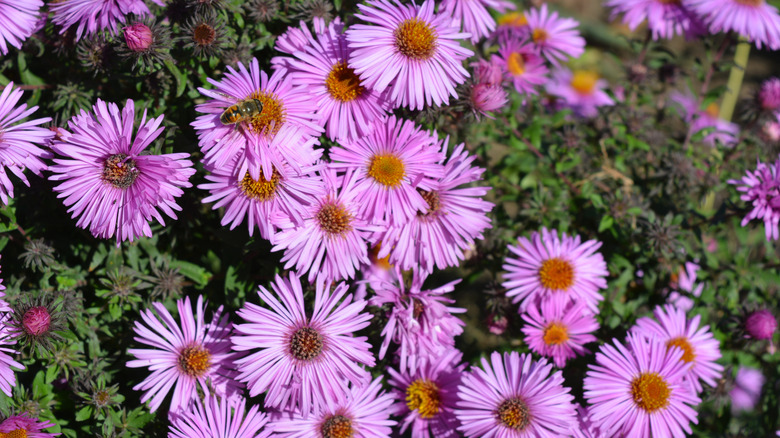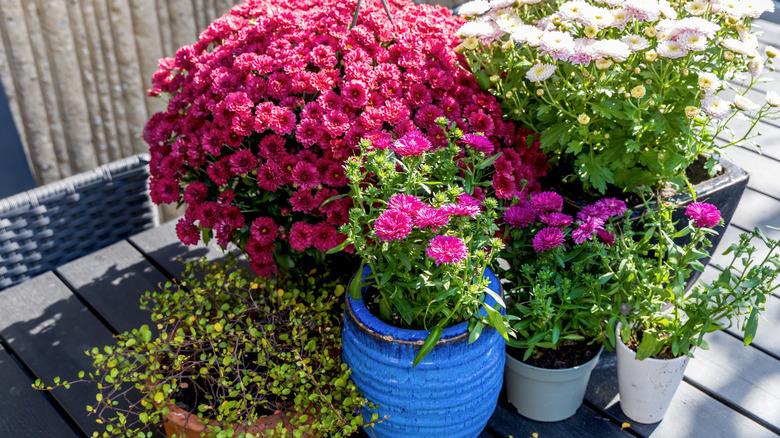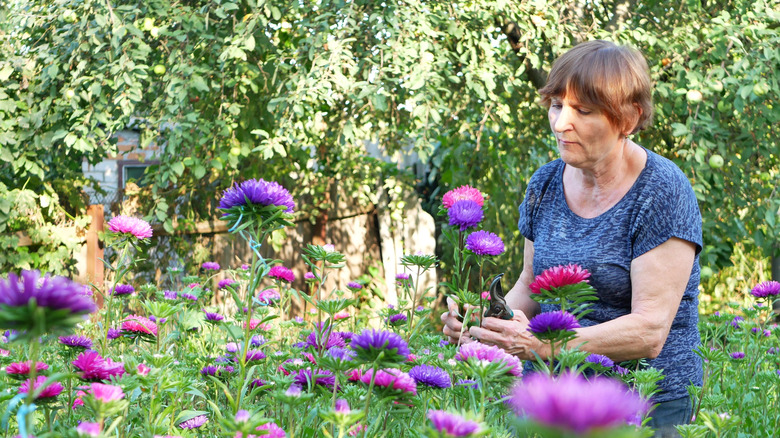How To Grow Beautiful Fall Asters Without Messing Up Your Garden Beds
That feeling when your asters suddenly start popping up where your tulips are supposed to be next spring is a common frustration with gardeners. These late-season perennials are valued for their daisy-like flowers that bloom when others are fading at the end of the season, and can be found in various shades of white, purple, pink, and blue. Asters belong to the Asteraceae family and species formerly categorized as aster that are native to North America have been moved to two different genera, Symphyotrichum and Eurybia. Despite these changes, the common name aster is still used for plants in all three groups. Many varieties of aster grow rapidly with the help of underground stems called rhizomes, and can quickly turn into bullies, pushing out less assertive neighbors. A good way to enjoy the color of fall asters without them taking over the garden is to grow them in containers.
Most aster varieties are cold-hardy and thrive in USDA Hardiness Zones 3 through 8. Container planting allows you to take control over these fast-growing plants and enjoy their autumnal display – a great substitute for florist mums – without worrying about where they'll spread next.
Choosing the right container
The reason for container planting asters is to make sure they don't spread throughout the garden, so choosing the right size pot is important. Aster varieties vary in size, and some taller types, like the New England aster, can reach heights of 5 feet, meaning the pot needs to be large enough to prevent the plant from becoming top-heavy and tipping over. A good rule of thumb is to choose a pot that is approximately as wide as the plant's anticipated height and at least half as deep. This gives the plant room to grow without becoming pot-bound.
It's also important that the pots have drainage holes. Asters dislike wet roots, and excessive moisture can lead to root rot and fungal disease. Making sure the plants have enough water can also prevent the flowers from turning brown. Use loose, well-draining soil and plan on dividing your potted asters every three to four years. This can be done by removing the root ball, slicing it into smaller sections with a clean blade, and repotting them into different pots with fresh soil.
The best time to plant asters in pots depends on whether you're using seeds or seedlings. If planting seeds, sow them in the spring about 8 to 10 weeks before the last frost and then transplant them after the frost is gone and true leaves appear. Seeds can also be sown in autumn, but they won't bloom until the next year. For seedlings, plant in mid- to late spring after the last frost, or during early autumn, giving them six to eight weeks to root before heavy frost.
Seasonal maintenance for maximum blooms
Potted asters need different care than those planted in a garden bed. The limited amount of soil in a pot causes it to dry out faster, especially during hot weather, which means they need more water. Check pots daily and water until excess drains from the bottom, keeping soil consistently moist but never soggy. Wet foliage is prone to powdery mildew, so keeping the leaves dry is a good idea.
Pruning during the summer season is another important step when taking care of potted asters. To help the plant grow wider and produce more flowers, you can pinch back the stems by about one-third, repeating this process once or twice through mid-summer. It's important to stop all pruning by early July, since this gives the flower buds enough time to set for their autumn bloom.
Asters typically aren't heavy feeders, and if your potting mix already has a slow-release fertilizer, extra won't be needed. If you do choose to feed them, use a diluted, balanced, water-soluble fertilizer sparingly throughout the summer. Avoid high-nitrogen products, which encourage more leaf growth than flower production. When the first frost arrives, cut the plant back to a few inches above the soil line and move the pots to an inside, non-freezing location, like an unheated garage, to keep the roots protected during the cold winter months.


